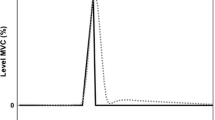Abstract
In the present study, we seek to investigate how the sequence of neuronal events that include stimulus identification, motor planning, and movement execution is implemented in the cortical neural networks, using an experimental paradigm that segregates between preparation and motor activation. For this study, twenty-two right-handed subjects had EEG signals recorded and analyzed. The subjects were divided into two groups. The imagery group performed real right or left forearm movements or the imagination of these movements. The control group performed real movement of the right or left forearm or did not perform any movement (wait condition). The Event-Related Spectral Perturbation (ERSP) in each one of the experimental conditions was compared for the time intervals of preparation, execution, and after-movement end. We observed: (I) mu and beta desynchronizations (ERD) for movement and imagery and not for the wait condition, during preparation and execution periods. (II) The movement ERD is greater than the imagery ERD for both mu and beta bands. (III) Synchronization (ERS) after the movement is finished. (IV) Greater mu ERD during the execution period and beta ERS after the movement ends at the contralateral channels in the movement condition. (V) Gamma ERS after the movement ends for the movement condition, and not for wait. These findings suggest that using signals from the contralateral region of the movement to be executed might impact the accuracy of the control of devices in a brain-computer interface paradigm.
Access this chapter
Tax calculation will be finalised at checkout
Purchases are for personal use only
Similar content being viewed by others
References
McFarland, D., Wolpaw, J.: EEG-based brain–computer interfaces. Curr. Opin. Biomed. Eng. 4, 194–200 (2017). https://doi.org/10.1016/j.cobme.2017.11.004
Molinari, M., Masciullo, M.: Stroke and potential benefits of brain-computer interface. Handb. Clin. Neurol. 168, 25–32. Elsevier (2020). https://doi.org/10.3390/s21134312
Sharma, N., Pomeroy, V.M., Baron, J.-C.: Motor imagery: a backdoor to the motor system after stroke? Stroke 37, 1941–1952 (2006). https://doi.org/10.1161/01.STR.0000226902.43357.fc
Fernández-Gómez, E., Sánchez-Cabeza, Á.: Imaginería motora: revisión sistemática de su efectividad en la rehabilitación de la extremidad superior tras un ictus. Rev. Neurol. 66, 137 (2018). https://doi.org/10.33588/rn.6605.2017394
Santos-Couto-Paz, C., Teixeira-Salmela, L., Tierra-Criollo, C.: The addition of functional task-oriented mental practice to conventional physical therapy improves motor skills in daily functions after stroke. Braz. J. Phys. Ther. 17, 564–571 (2013)
Page, S., Szaflarski, J., Eliassen, J., Pan, H., Cramer, S.: Cortical plasticity following motor skill learning during mental practice in stroke. Neurorehabil. Neural Repair 23, 382–388 (2009). https://doi.org/10.1177/1545968308326427
Page, S., Levine, P., Sisto, S., Johnston, M.: A randomized efficacy and feasibility study of imagery in acute stroke. Clin. Rehabil. 15, 233–240 (2001). https://doi.org/10.1191/026921501672063235
Kansaku, K., Cohen, L., Birbaumer, N.: Clinical Systems Neuroscience. Springer, Tokyo, Japan (2015). https://doi.org/10.1007/978-4-431-55037-2
Pfurtscheller, G., Aranibar, A.: Evaluation of event-related desynchronization (ERD) preceding and following voluntary self-paced movement. Electroencephalogr. Clin. Neurophysiol. 46, 138–146 (1979). https://doi.org/10.1016/0013-4694(79)90063-4
Pfurtscheller, G., Lopes da Silva, F.: Event-related EEG/MEG synchronization and desynchronization: basic principles. Clin. Neurophysiol. Off. J. Int. Fed. Clin. Neurophysiol 110, 1842–57 (1999). https://doi.org/10.1016/s1388-2457(99)00141-8
Galdo-Alvarez, S., Bonilla, F., González-Villar, A., Carrillo-de-la-Peña, M.: Functional equivalence of imagined vs. real performance of an inhibitory task: an EEG/ERP study. Front. Hum. Neurosci. (2016). https://doi.org/10.3389/fnhum.2016.00467
Tallon-Baudry, C., et al.: Oscillatory gamma activity in humans and its role in object representation. Trends Cogn. Sci. 3(4), 151–162 (1999). https://doi.org/10.1016/s1364-6613(99)01299-1
Amo Usanos, C., et al.: Induced Gamma-Band Activity during Actual and Imaginary Movements: EEG Analysis. Sensors (Basel, Switzerland), vol. 20, no 6, (2020). https://doi.org/10.3390/s20061545
Kilavik, B., Zaepffel, M., Brovelli, A., MacKay, W., Riehle, A.: The ups and downs of β oscillations in sensorimotor cortex. Exp. Neurol. 245, 1526 (2013). https://doi.org/10.1016/j.expneurol.2012.09.014
Weinrich, M., Wise, S.: The premotor cortex of the monkey. J. Neurosci. 2, 1329–1345 (1982). https://doi.org/10.1523/JNEUROSCI.02-09-01329.1982
Crammond, D., Kalaska, J.: Prior information in motor and premotor cortex: activity during the delay period and effect on pre-movement activity. J. Neurophysiol. 84, 986–1005 (2000). https://doi.org/10.1152/jn.2000.84.2.986
Makeig, S.: Auditory event-related dynamics of the EEG spectrum and effects of exposure to tones. Electroencephalogr. Clin. Neurophysiol. 86(4), 283–293 (1993). https://doi.org/10.1016/0013-4694(93)90110-h
Klimesch, W., Sauseng, P., Hanslmayr, S.: EEG alpha oscillations: the inhibition-timing hypothesis. Brain Res. Rev. 53, 63–88 (2007). https://doi.org/10.1016/j.brainresrev.2006.06.003
Takemi, M., Masakado, Y., Liu, M., Ushiba, J.: Event-related desynchronization reflects downregulation of intracortical inhibition in human primary motor cortex. J. Neurophysiol. 110, 1158–1166 (2013). https://doi.org/10.1152/jn.01092.2012
Acknowledgment
The authors thank CNPq (Conselho Nacional de Desenvolvimento Científico e Tecnológico) and FAPERJ (Fundação de Amparo à Pesquisa do Estado do Rio de Janeiro) for their financial support during the production of this work.
Author information
Authors and Affiliations
Corresponding author
Editor information
Editors and Affiliations
Rights and permissions
Copyright information
© 2024 The Author(s), under exclusive license to Springer Nature Switzerland AG
About this paper
Cite this paper
da Silva Pereira, A. et al. (2024). Differential Event-Related Spectral Perturbation for Left and Right Elbow Movement for Applications in a Brain-Computer Interface. In: Marques, J.L.B., Rodrigues, C.R., Suzuki, D.O.H., Marino Neto, J., García Ojeda, R. (eds) IX Latin American Congress on Biomedical Engineering and XXVIII Brazilian Congress on Biomedical Engineering. CLAIB CBEB 2022 2022. IFMBE Proceedings, vol 99. Springer, Cham. https://doi.org/10.1007/978-3-031-49404-8_33
Download citation
DOI: https://doi.org/10.1007/978-3-031-49404-8_33
Published:
Publisher Name: Springer, Cham
Print ISBN: 978-3-031-49403-1
Online ISBN: 978-3-031-49404-8
eBook Packages: EngineeringEngineering (R0)




